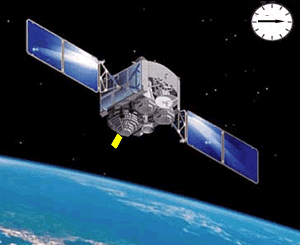The question we ask is "What do we need to know about the Universe to allow us to construct such a sophisticated system?"
The answer? general relativity and gravity.


Lets start with Einstein
Einstein explained what gravity is through his theory of general relativity. Unlike Newton, who described gravity as a force, Einstein defined gravity as a warping of space and time. Take a look at the animation on the right. It shows two neutron stars spiraling into each other in the process of forming a black hole. This process creates intense gravity that warps time and space.

Lets take a simple example of throwing a ball. In the absence of gravity the ball continues in a straight line.
However, in the presence of gravity the ball takes a parabolic path as it falls back to Earth. Newton would explain this as the force of gravity acting on the ball to pull it back to Earth, but Einstein explained that it has nothing to do with force and everything to do with time.

Let's throw three balls with clocks on them as shown on the right. We measure the time it takes each ball to travel its unique trajectory by placing a clock on each ball.
As you can see ten seconds has elapsed for the two clocks on the ground. However the clocks in motion have different times, for two reasons:
One - moving clocks tick slower than stationary clocks. The faster a clock travels the slower time passes:
Two - gravity warps time.

Ball "C" takes 7 seconds to complete its journey, significantly less than the ten seconds registered by our stationary clocks. This is due to the fact it is moving and that gravity warps time and so time elapses slowly for clocks near the surface of the Earth than clocks high above the Earth.
Ball "B" takes more time than "C" and this can be explained due to time warping by gravity being less further away from Earth.
But ball "A" is further from Earth and yet less time has elapsed than ball "B". This is due to the fact that ball "A" has to travel faster, as its path is longer than the other two.

If I hold two clocks, one above my head and one near my waist, as shown on the right, clock "A" would
Two twins are used for an experiment. One stays on the ground at the airport while the other flies a super sonic jet around the world. Upon his return both twins are taken and examined. Which is the most likely scenario?
An astronaut travels through space at the speed of light. Explain how he has changed when he returns to Earth.

Many satellites orbit the Earth. We can precisely calculate our position and altitude on Earth by measuring our distance from at least three satellites. This distance is calculated by measuring the time it takes for a signal from a satellite to reach the receiver on Earth.
Why do we have to consider Einstein's general relativity in order for our GPS to work?
How will the time differ between the satellite and land based receiver?
A satellite transmits a signal. The signal is timed by an onboard atomic clock and a land based atomic clock on the surface of the Earth. If the time was taken from the satellite clock and not adjusted the distance would most likely be
What is triangulation. Give an example.

In order to calculate where we are on Earth we need to measure the
What would happen to the onboard clock of a space ship that entered a black hole?
